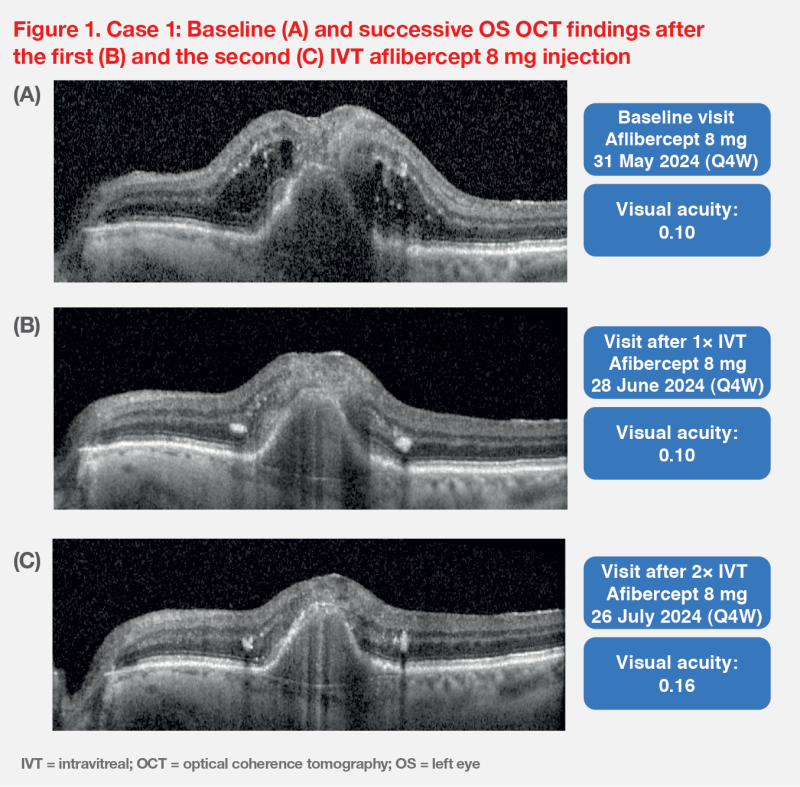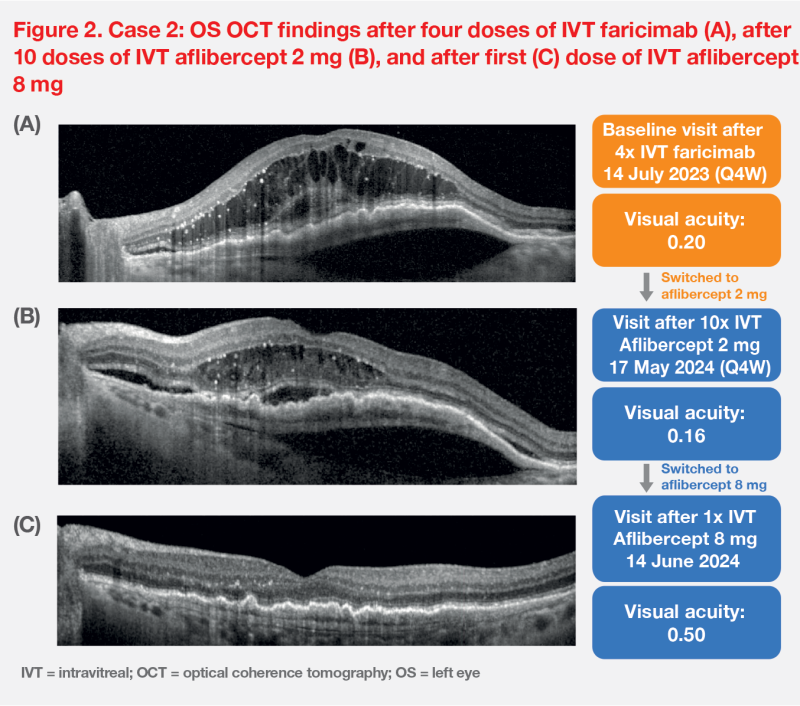VEGF inhibitor high-dose formulation sustains disease control, extends treatment interval in nAMD





Case 1: Aflibercept 8 mg in a patient with treatment-naïve nAMD and POAG
History and presentation
An 89-year-old male with bilateral (OU) pseudophakia and primary open-angle glaucoma (POAG) was being monitored for neovascular age-related macular degeneration (nAMD) in the left eye (OS). He used an Amsler grid to monitor his visual function.
On 29 May 2024, the patient reported OS visual acuity (VA) deterioration.
Treatment and response
On 31 May 2024, optical coherence tomography (OCT) findings indicated type 3 macular neovascularization (MNV) OS, with intraretinal fluid (IRF), subretinal fluid (SRF), disorganization of retinal outer and inner layers (DRIL), and hyperreflective foci (HRF). Fundus exam showed intraretinal haemorrhage. OS VA was 0.1 (20/200). (Figure 1A) Baseline OS volumetric analysis using the Discovery Platform (RetinAI) showed IRF of 1,382 nL, SRF of 288 nL, and pigment epithelial detachment (PED) volume of 526 nL.

The patient received intravitreal (IVT) injections of an anti–vascular endothelial growth factor (anti-VEGF), aflibercept 8 mg for three consecutive monthly doses.1 He tolerated the treatment well. No increase in intraocular pressure (IOP) or any other adverse events (AEs) was observed.
On 28 June 2024, 1 month after the first dose of aflibercept 8 mg, OCT OS revealed a dry retina within the central 1 mm ETDRS grid, and the fluid volumes already significantly decreased. (Figure 1B) The patient received the second IVT aflibercept injection OS on the same day.
On 26 July 2024, VA OS improved to 0.16 (20/120) with the second dose. OCT and volumetric analysis OS continued to show improved outcomes. (Figure 1C) The central retina remained dry, with IRF decreasing from 1,382 to 25 nL, SRF from 288 to 1 nL, and PED from 525 to 494 nL. HRF had resolved.
After three loading doses, a treat-and-extend (T&E) regimen for IVT aflibercept 8 mg is planned, with the next injection to be administered at 8 weeks since the last injection, then up to Q20W if his nAMD remains stable.
Case 2: Using aflibercept 8 mg in a patient with heavily pretreated nAMD
History, presentation and prior treatments
A 66-year-old female patient with OU phakic lenses and controlled type 2 diabetes (T2D) was diagnosed with nAMD OS on 22 November 2021. She was a heavily pretreated patient who had received multiple IVT therapies (ie, aflibercept 2 mg, brolucizumab 6 mg, and faricimab 6 mg), totalling 29 injections between 26 November 2021 and 19 April 2024.
During these treatments, she could not extend treatment intervals beyond 4 weeks due to nAMD recurrence with worsening of VA and OCT OS findings.
After completing four doses of faricimab on 14 July 2023, her OS VA had decreased to 0.2 (ie, 20/100). OCT OS showed IRF, SRF, a large prechoroidal cleft and HRF, along with bacillary layer detachment and PED. (Figure 2A)

On 14 July 2023, the patient switched back to IVT aflibercept 2 mg. Successive OCT OS findings showed improved and stable VA, ranging from 0.50 to 0.63 (20/40–20/32), but treatment intervals remained at Q4W due to nAMD recurrence.
On 17 May 2024, 1 month after the 10th dose of IVT aflibercept 2 mg, OCT OS revealed recurrence of bacillary layer detachment, IRF, SRF and the prechoroidal cleft. (Figure 2B) OS volumetric analysis showed IRF of 1,033 nL, SRF of 837 nL, and PED volume of 3,881 nL, while VA OS worsened to 0.16 (20/120).
Aflibercept 8 mg treatment and response
Because of disease recurrence, the patient received IVT aflibercept 8 mg OS on 17 May 2024. She tolerated the treatment well and did not experience any AEs.
On 14 June 2024, 1 month after the first dose of aflibercept 8 mg, OCT OS showed a completely dry retina (ie, IRF and SRF of 0 nL; PED volume of 1,159 nL) and the prechoroidal cleft had completely resolved. Her VA also improved from 0.16 (3/19) to 0.50 (20/40). (Figure 2C)
Currently, the patient’s condition remains stable, with a VA of 65 letters and a treatment interval extension from Q4W to Q6W.
Discussion
Excessive activation of the VEGF receptor (VEGFR)-1/2 pathway is central to the pathogenesis of exudative retinal diseases like nAMD, for which anti-VEGF agents are the standard of care.2-6 Compared with other anti-VEGFs, the multitargeted anti-VEGF agent, aflibercept, binds to the most diverse range of VEGFR-1/2 ligands, including VEGF-A, VEGF-B, placental growth factor (PIGF) and galectin-1, which are key drivers of retinal diseases.2,7 Aflibercept also has the highest reported potency and binding affinity to VEGF-A among the available IVT therapies.8,9
The efficacy and safety of aflibercept 2 mg are well established.10,11 Increasing the dose to 8 mg may further reduce treatment burden by providing a four-fold higher molar dose, potentially prolonging ocular VEGF inhibition.12
The approval of aflibercept 8 mg for nAMD is based on PULSAR, a 96-week, randomized, double-blind phase III noninferiority study involving 1,009 adult patients with nAMD who received either aflibercept 8 mg at Q12W (n=335) or Q16W (n=338), or aflibercept 2 mg at Q8W (n=336), after three initial monthly injections.13
At week 16, the pooled aflibercept 8 mg group demonstrated superior drying effect vs aflibercept 2 mg (proportion of patients with no retinal fluid in the centre subfield, 63 vs 52 percent; 95 percent confidence interval, 5–18; p=0.0002).13
At 48 weeks, the aflibercept 8 mg Q12W and Q16W dosing regimens showed noninferior best-corrected VA (BCVA) gains vs aflibercept 2 mg Q8W (mean BCVA change from baseline, +6.7 and +6.2 letters, respectively, vs +7.6 letters).13
At week 96, 78 percent of patients on aflibercept 8 mg Q16W achieved a last assigned treatment interval of ≥Q16W, while 53 percent achieved ≥Q20W (Q20W, 22 percent; Q24W, 31 percent). Safety profiles were also comparable between the two doses.14
These results demonstrated that IVT aflibercept 8 mg improves treatment outcomes and provides rapid and sustained disease control in patients with nAMD while allowing treatment interval extensions.15 This may be due to the increased molar dose of the 8 mg formulation and the associated up to 34 percent slower ocular clearance vs the 2 mg formulation. On average, aflibercept 8 mg is estimated to stay in the eye for 6 weeks longer than aflibercept 2 mg.16
Our patients’ early positive experiences aligned with those observed in PULSAR.13 Both of our treatment-naïve and heavily pretreated patients demonstrated notable improvements in VA following aflibercept 8 mg injection, with rapid drying of the retina observed immediately after the first dose.
In our first patient, high-dose aflibercept was associated with early improvements in functional and anatomic outcomes despite the rapid nAMD progression and poor OCT findings. Early intensive treatment with aflibercept 8 mg may have been of particular benefit to this patient due to the responsiveness of type 3 MNV to anti-VEGF treatment. Aflibercept 8 mg is also indicated for diabetic macular oedema (DME), which could be advantageous for our second patient with potential underlying diabetic component.1,17
Our patient with POAG did not experience increased IOP, consistent with PULSAR results showing comparable IOP at any timepoint across all treatment groups. The safety profile of aflibercept 8 mg was comparable to that of aflibercept 2 mg, with no new safety concerns identified and a low rate of intraocular inflammation (1 percent for both groups).13 Since increased injection frequency may be a risk factor for chronic ocular hypertension, aflibercept 8 mg may be an ideal option in patients with nAMD complicated by POAG due to potentially lower treatment burden.1,18
Sustained disease control with aflibercept 8 mg also aligned with the experience of our second patient, who was previously unable to extend her treatment interval beyond Q4W despite having tried multiple IVT agents in the past. After the first administration of aflibercept 8 mg, she had a completely dry retina and improved VA. Her treatment interval also extended to Q6W for the first time, providing an additional 50 percent extension from her first injection.13 This reduction in treatment burden and minimization of monitoring visits allowed the patient more time to enjoy with her grandchildren.15
Anxiety related to IVT and its AEs, as well as the frequent clinic visits, are common barriers for patients with nAMD receiving anti-VEGF therapy.19,20 New treatments like aflibercept 8 mg may help address these concerns.
In summary, aflibercept 8 mg is associated with improved functional and anatomic outcomes and extended treatment intervals, with a similar safety profile as aflibercept 2 mg. Clinically, high-dose aflibercept may be considered for all patients with nAMD, including treatment-naïve patients and those switching from aflibercept 2 mg or other IVT therapies.